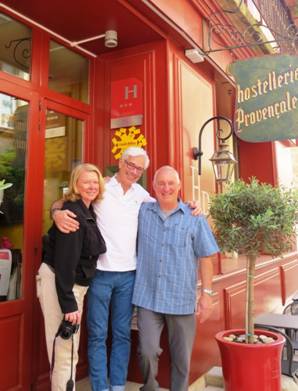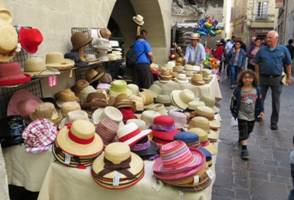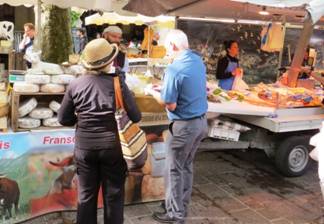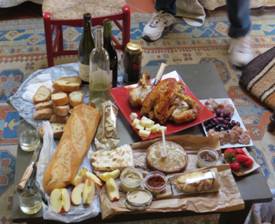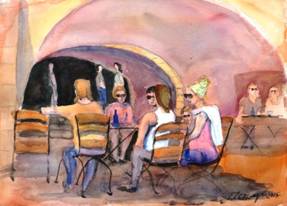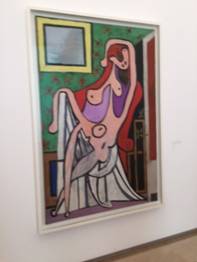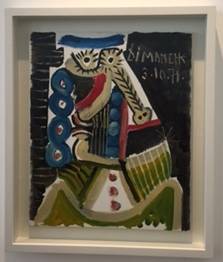
The WorldWorstTourist Paints France-Another Go with Art Master Tim Clark
Chapter 4-From the Medieval to the Modern-Uzes, Paris and more Picasso
May, 2015
8 May Friday-Uzes
On Friday we moved from Collioure to Uzes, another medieval walled city, where we stayed near the market place in Hostellerie Provenciale, operated by Eric.
Mary, Zeke, and our host Eric at Hotel Provincial
Uzes Market Day, one of the best in France
Our accommodation was spectacular. Zeke and I had a large, top floor corner room, filled with art, with good views on two sides, a Jacuzzi, and an outdoor patio. We were within steps of the “best marketplace” in France and across the street from the Uzes cathedral. The marketplace, with its fountain and surrounding architecture would be a wonderful place to paint, but Tim warned us that Saturday was market day, and it would be practically impossible to paint in the square.
In the morning, when we entered the market, the place was buzzing with every manner of sales booths and wall to wall people, verifying Tim’s warning. Nevertheless, like many times before, as though getting extra help from the universe while pushing through dense crowds, I spotted a hallway that, for some reason, was completely abandoned. Almost too good to be true, it provided a clear view over the market, and a few of us sat up easels and painted the rest of the morning. I kept wondering when someone would show up and kick us out, but no one did. I still do not know why there were no people in that hallway.
Purchasing Lunch in the Uzes marketplace
A French Picnic-We even purchased the knives in the market
Lunch Break, 11x15, watercolor on paper
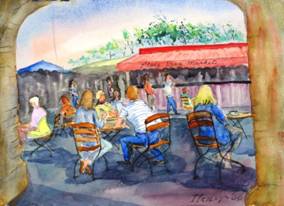
Coffee Break, 11x15, watercolor on paper
Painting the Uzes Marketplace
After a picnic with food and wine purchased in the market, I scouted the city for other painting sites. During lunch a few of us had decided to do a sunrise painting the next day, so, guessing where the sun would rise, we identified a few potential painting spots, reserving the final selection for the morning.
The square hosted a flower market on Sunday, which would be less crowded, and Tim announced that he would do a demonstration after breakfast in one of the corners of the square. I rose at 5:30 AM and left the hotel in the dark at 6 AM. One of our potential spots on the east side of the church was perfect. Sunrise painting is my favorite of all plein air painting, although possibly the most difficult because of rapid lighting changes. The large changes in lighting are observable only if you are really careful, since our eyes compensate (“You can see a lot by observing”). Sunrise colors are warm and beautiful with cool shadows that must be determined early. After sunrise, a clear blue sky illuminates with cool colors and shadows become warm. Using a few of Tim’s techniques, I determined the color of the shadows, focused on the scene for several minutes before starting, and then closed my eyes and saw the painting sitting on my blank paper, imagining how it was defined by a few major shapes and a few colors, also imagining the foreground and background. I had it burned into my mind. By the time we left for the hotel breakfast the colors were nothing like they were at the outset, and further work on it seemed to be taking me backwards.
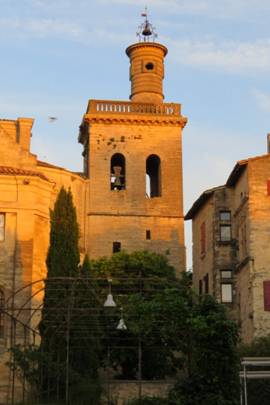
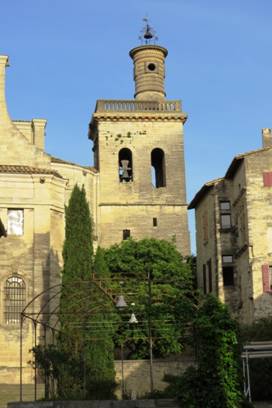
Uzes church at sunrise and at eight. Notice the change of colors.
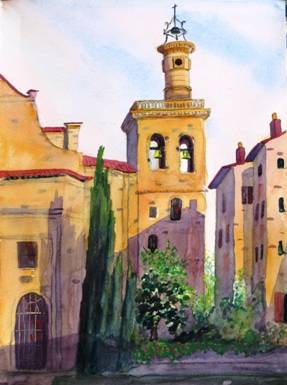
Uzes Cathedral, 11x15, watercolor on paper, painted in Uzes, France
Being a bit behind schedule, I was the last one to leave the hotel to return to the market, where Tim’s demonstration would be held. As I rushed to catch up, I met a few artists hastily leaving the market, coughing and rubbing teary eyes. The winds, blowing in the trees and flowers, had filled the air with pollen, which was intolerable to many people with the result that the demo had been called off. Not being bothered by the pollen, I toured the flower market then returned to my morning painting spot to see if I could finish the painting I had started. I still had the feeling of sunrise in my head, but the painting had moved in the wrong direction, so I started over, using the scene before me just for the drawing and then painting from the feeling. The finished painted matched my “sunrise” feeling much better this way.
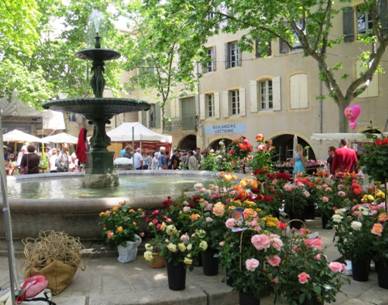
The Uzes Flower Market
In the afternoon, we took a side trip to nearby Pont du Gard, a world heritage site and one of the oldest and most spectacular Roman aqueducts.
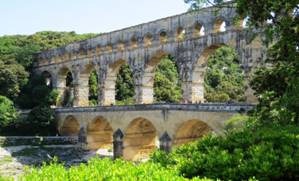
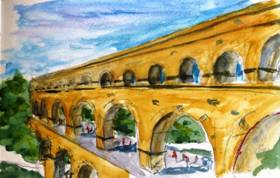
Pont du Gard
At first this looked like another one of those places where finding a suitable painting spot is impossible, since every good view site is filled with tourists doing selfies. Nevertheless, Zeke and I crossed over the river and climbed one of the banks and happened upon a perfect spot, by working our way down an embankment to a clearing with a perfect view of the aqueduct.
Painting the arches of the Pont du Gard reminded me of the second known optical truth I had to abandon after this trip. I had learned from Tim years ago how to plot circles and arches in perspective. That was not a problem here. However, I had also learned in university many years ago how to plot ellipses and that when you tilt a circle, what you see is an ellipse. Draftsmen do that routinely. So I have “known” that the tops of these arches are elliptical; they are not. A tilted circle would appear as an ellipse without correction for perspective. When you correct for perspective, the furthest half of the circle is smaller than the closest half, so the two halves cannot make an ellipse. It took me 55 years to discover that something I learned in engineering drafting was only approximately incorrect.
11 May Monday- Paris
We said goodbye to Uzes, made a brief stop at Avignon and took a two and half hour train to Paris. Our bus driver met us at the station and drove up and down the Seine River passing well known places such as Notre Dame Cathedral, the Musee d’ Orsay, the Louvre, the Eiffel Tower, and the Arc de Triomphe on the way to our hotel. We arrived at the Hotel Pavillon de la Reine, centered in an art district at Place de Voges, in mid afternoon. A brief demonstration in a nearby park left enough time to walk to the Notre Dame, do a little sketching, and return to join others for a café dinner search. Jeff had located a small square near the hotel that was lined with sidewalk cafes. When we first arrived, all of the outside café seats appeared to be full; however, one of the waiters spotted us, brought out a table and created six new seats to accommodate us.
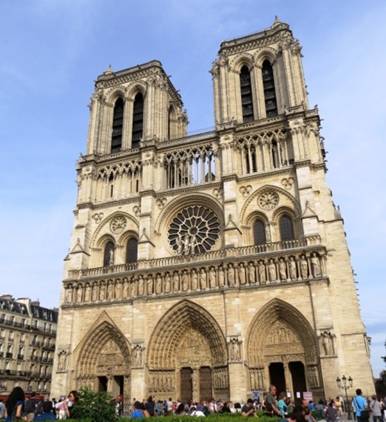
Notre Dame Cathedral
12 May, Tuesday-Picasso Museum
We began our last full day in Paris by visiting the Picasso Museum. I have seen a lot of Picassos in previous museum visits, but never anything like this, a three story building packed with Picasso drawings, sculpture, ceramics, woodwork and his own collection, which included Renoir, Matisse, Chardin, Cezanne, and others.
Being somewhat skeptic with what people call art I could see here an artist who never threw away anything he produced, regardless of its quality or true value as an art object. The art field would have been better off if he had thrown at least half of this stuff in the bin; it’s just junk. Unfortunately, we create artists like Picasso by placing a high value on anything with his name on it, regardless of what it is. This state of affairs made him extremely rich, since he could turn a piece of scrap into spendable currency by simply scribbling on it. Today’s art world is full of people like that, and signatures sell regardless of the art quality, with no one can knowing for sure if it is good art. If a scrap with his name on it would sell for thousands of dollars, who could blame him for saving it? Maybe he was so egotistical that he actually thought that when he created something it was automatically great art. Maybe he thought he was a god. I cannot see how any honest art critic would consider some of the stuff in the Picasso Museum truly worthy of a place on anyone’s wall.
I have never seen so many displays of phallic symbols, vulgar, hideous, pornographic pictures in one place. A few hours in the Picasso Museum firmed up my belief that Picasso, though truly a great artist, did more damage than good to the field of art by allowing much of this stuff to continue its existence. He simply took advantage of the fame we gave him while filling museums with junk we now must call art. How have we come to believe that the signature trumps anything in the painting? A genuine art community would place a high value on much of Picasso’s work while at the same time rating some of it as worthless. Today, we honor and reward many artists who rise in the ranks, not through skill and genius, but through marketing and promotion, and even worse, we are no longer even sure what art really is. Picasso played a major role in creating generations of artists who have become rich through controversy, shock, outrage and absurdity and he played an important role in helping salesmen and dealers high jack fine art.
Works like these have become nothing more than a means for the wealthy to safely store value and have nothing to do with art. The buyers don’t even have to store and protect it; they loan it to museums, where it is guarded and cared for at taxpayers’ expense. To make this even more ridiculous, we then praise the wealthy for being so generous, when few of us would want to hang some of this crap on our own walls? Why do we waste so much wall space in museums?
How could you get more pornographic?
A typical Picasso phallic symbol painting. I call it Dick Head
The building in which the works are housed is a true artwork itself, as is the top floor, Picasso’s collection of art by his friends, and it serves as a good palate freshener before leaving the museum.
We liked the square where we had dinner the evening before so much that we returned there for lunch. After lunch I found a bench in the square and made small studies of people eating in the surrounding cafes, including Chez Josephine where we had lunched. The bad news is that many of the diners sit and stare at their cell phones. The good news is that people staring at cell phones don’t move much, making them easy to draw.
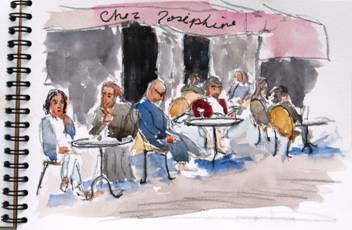
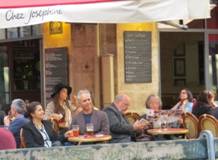
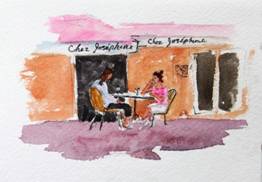
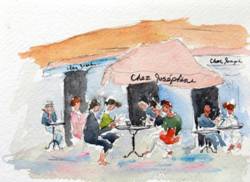
Café Josephine, where we lunched
For our final, farewell dinner Tim had arranged a fine dinner at a private club, Cercle de l'Union interalliée, a social club for international public figures. This is one of those places that tempt one to put pictures of each dish on Facebook.
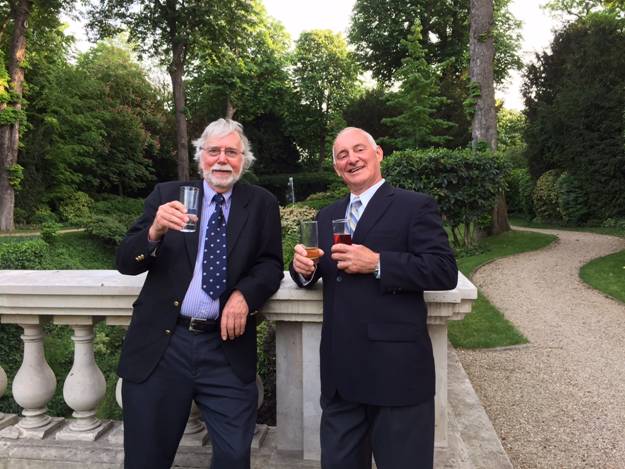
Jim with friend and roommate, Zeke. Zeke is holding Clytie’s drink while she takes the photo.
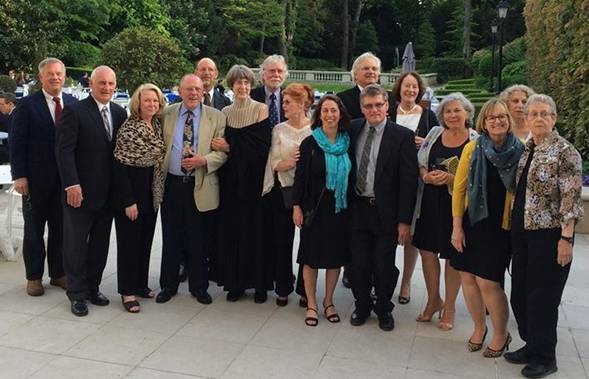
They look too spiffy to be artists, but spiffy was the house rule at our last dinner.
On Wednesday, 13 May I left Paris for London. Tim walked me to the taxi to bid farewell. About half way there, he stopped me and paid me one of the nicest compliments yet. During the week he had discussed the French artist movement on several occasions. One of his anecdotes described how many of the great artists began their careers in Languedoc in Southern France and worked their ways towards Paris as they got more and more established. Eventually, when they were accepted in Paris, they were seen to have made it as artists. He looked at me, held out his hand and said, “Congratulations. You have made it to Paris. Welcome to the family”. I mounted the taxi, headed for the Paris Gare du Nord, took the 9 AM Eurostar, and was back in London by noon.
The 12 day trip was a rewarding, eventful, fun, educational event with every minute filled with learning experiences, laughter, and awe. As with most days in my life, fleeting time prompts a struggle to choose from too many interesting things to do; 12 days in France came and went in a flash, and I wish I could do it all over again and choose some of the options put aside for choices made. Once again I feel blessed with so many unique signs and gifts the universe provides. I only hope I didn’t overlook too many that I failed to recognize as gifts and did something worthwhile with the ones I did.
Paraphrasing Tim-
Question: "Tim, how do you tell which side of water color paper you should pain on?"
Answer:"Paint on the side facing you."
“Before committing anything to paper, look at the scene intensely, then close your eyes and see the painting you wish to create. Locate a few defining shapes and values. See what is in the background.”
“If you paint anything long enough, you become a part of it.”
“Paint what you love.”
Postscript-After returning to England, I stuck with my vow to paint the little Floure muse negotiator based on photographs I took and my experience of her pleading with me to “sell” her a painting. Assuming that Floure is a small enough village, I mailed to painting to Gerry, our hotel manager and requested that he pass the painting on to the local school and ask them to give it to her.
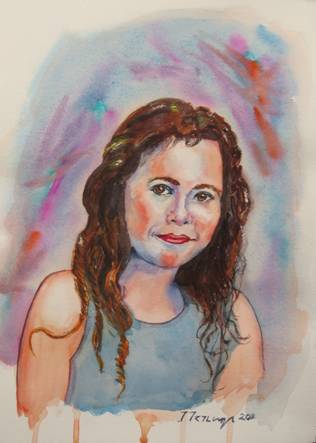
Floure Muse Negotiator, 11x15, watercolor on paper
